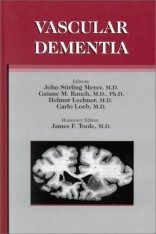|
|
|
| |
 |
|
|

|
 推薦指數:
推薦指數:





|
|
- 內容介紹
|
Vascular Dementia
by John Stirling Meyer (Editor)
Hardcover (January 15, 2001)
Futura Pub Co; ISBN: 0879934255
Editorial Reviews
From the New England Journal of Medicine, June 14, 2001
This book summarizes the latest information on the diagnosis and treatment of patients with vascular dementia. The authors, experts in the field, wrote this updated edition for neurologists and others who care for our growing elderly population. Vascular dementia is potentially more amenable to treatment than Alzheimer's disease.
Experts in dementia do not agree on basic diagnostic criteria, which makes discussing vascular dementia inherently difficult. Since Hachinski defined the original criteria for multi-infarct dementia in the 1970s, several additional sets of diagnostic criteria have been developed. All are useful, but they vary substantially. As a result, many physicians feel uncomfortable making the diagnosis of vascular dementia. The authors should be commended for their authoritative manual, which summarizes clearly the growing body of information on this disorder. After reading the book, physicians will have an improved sense of what vascular dementia is and how to identify its major subtypes.
The book has other strong points. It emphasizes management by medication and through the aggressive identification and modification of risk factors. Although one could argue with some of the recommendations, it is refreshing to see a book on dementia that stresses management. Individual chapters are easy to read, and there is little contradictory information in the different chapters -- a plus in a multiauthored book. However, the excessive overlap between chapters can be annoying, and the topics do not flow into one another easily. The book would have been improved by the addition of an overview at the beginning of the book to summarize the subtypes of vascular dementia and describe their classification. The chapters on clinical diagnosis and disease classification appear in the middle of the book (chapters 10 and 11), which means that the reader comes on subtypes of vascular dementia before understanding how these subtypes fit into the overall picture.
The chapter on Binswanger's disease is a well-written basic description of a confusing condition. However, some other sections could use greater depth. The introduction to cerebral autosomal dominant arteriopathy with subcortical infarcts and leukoencephalopathy is informative, but it should be expanded to include more information about the basis of this curious genetic disease. Since physicians often review neuroimaging studies to help them make a diagnosis, quantitative information about the severity of cerebrovascular changes that is necessary to cause dementia would be helpful. For example, many patients may have periventricular lesions or small infarcts and dementia. How severe must each abnormality be to determine that a patient's dementia has a vascular cause? A detailed discussion of each of the major lipid classes would help the clinician understand which levels to monitor. Does the evidence indicate that, for patients with vascular dementia, low-density lipoprotein, total cholesterol, or high-density lipoprotein should be adjusted, or is there an independent protective effect of administering lipid-lowering agents? The section on differential diagnosis would be stronger if it discussed more fully ways to distinguish vascular dementia from non-Alzheimer's types of dementia, including dementia with Lewy bodies and the less common subtypes of subcortical dementia.
The authors recommend a bold approach to the management of vascular dementia in their chapters on plasmapheresis and estrogen replacement. They give the reader the impression that these treatments are indicated, whereas many would argue that they are interesting ideas in need of further study. Since plasmapheresis is not used routinely for vascular dementia, this chapter should have included a more thorough discussion of the costs and risks associated with plasmapheresis, as well as any data that independently confirm their findings. In the chapter on the use of estrogens as neuroprotective agents in the treatment of dementia, the discussion of the potential risks associated with prolonged estrogen therapy is incomplete. The value of estrogen for this purpose is unproven, and given the risks involved, most physicians do not routinely recommend its use. The authors should have emphasized that there are no large studies supporting the use of estrogen for established dementia. Finally, the quality of all of the figures showing neuroimaging and histopathological findings could be improved, and there are more typographical errors than in most textbooks.
Nevertheless, I recommend the book for neurologists and other physicians with an interest in geriatric neurology, dementia, or cerebrovascular disease.
Carol F. Lippa, M.D.
Copyright © 2001 Massachusetts Medical Society. All rights reserved. The New England Journal of Medicine is a registered trademark of the MMS.
From Book News, Inc.
A new title signals the complete change of approach and the many new imaging techniques since the 1988 Vascular and Multi-Infarct Dementia. Neurologists and related professionals summarize for health care providers the current state of knowledge on preventing and treating dementia caused by vascular disorders, a growing problem as the population ages. New concepts concerning epidemiology, etiology, risk factors, neuropathology, pathogenesis, microvascular and hemorrhagic lesion, and ischemic... read more
|
|
|

